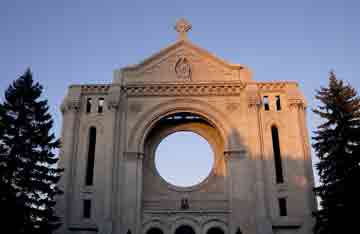By Todd Lewys
It’s that time of year again — Festival du Voyageur time, that is.
From February 16 to 25, Saint-Boniface — Winnipeg’s historic French quarter — will once again host Western Canada’s largest winter festival.
For 11 days, patrons will be able to get a taste of what life was like back in the days of the voyageur at Fort Gibraltar and through the various attractions that take place in Voyageur Park and the Festival’s other sites.
And while attractions like snow sculptures, old-time music and amazing shows will be front-and-centre, visitors to the Festival should also take the time to explore the many wonders of the area it’s held in: historic Saint-Boniface.
“It really is an area that’s full of history,” says Normand Gousseau, CEO of Saint-Boniface based Enterprises Riel, and former executive director of Festival du Voyageur. “What many people don’t know is that prior to the railway station being built, Provencher Boulevard was the same route as Broadway Street. It’s now classified as the Main Street of Francophone Manitoba.”
Not surprisingly, Saint-Boniface’s history extends to its architecture. Many of its buildings are 100-years-old or more. The result is a very cool collection of architectural styles.
“One example of the historic architecture in the Saint-Boniface Museum (located at 494 Tache Avenue), which is the oldest oak structure of its kind,” says Gousseau. “It not only looks historic, but it also offers a great inventory of information on Louis Riel and the early history of Manitoba.”
Then, there’s the Saint-Boniface Cathedral (180 de la Cathedral Avenue). It was established in 1818 in the Archdiocese of Saint-Boniface, and is a must-see with its forested location, iconic façade and impressive cemetery.
“The buildings alone in that area and on Tache are well worth taking the time to view,” he says. “You can see things like the Arch Bishop’s palace, and the tomb of Louis Riel. And the Cathedral is absolutely breathtaking.”
Then, for something more modern (a relative term in this case), visitors to Saint-Boniface looking for something to do before heading to the Festival might want to check out some vintage structures that date back to the early 1900s.
“You can view city hall, and the post office, which date back to around 1907-1908. In that sense, Saint-Boniface has been fortunate. Even though it’s an older community, most of the built infrastructure is still intact, though several historic structures on Provencher Boulevard were lost to fire over the years. You can even still see the home of famous author Gabriel Roy (on Des Meurons Street), who authored books such as the Tin Flute.”
While Saint-Boniface is teeming with historic architecture, it also features new structures.
One fine example is 500 Tache, a cutting-edge condominium development that faces on to the Red River from a lot surrounded by mature trees.
A second area worth noting is Pointe Hebert, a new enclave with homes featuring a diverse mix of
architectural styles — in an area that offers spectacular views of the
Esplanade Riel and downtown
Winnipeg.
Gousseau says the key to appreciating Saint-Boniface — which also offers several great eating spots such as the Marion Street Eatery, Resto-Gare, Inferno’s, Belle Baguette and Promenade Café & Wine — is to walk it.
“Take the time to get out of your car to walk around, stop, and have a look around the community. There are lots of great stories — Enterprise Riel offers tours — and Saint-Boniface offers a great vault of history.”
A good sample of that history can be experienced at the Festival, he adds.
“It’s a wonderful celebration of Manitoba history, and the Francophone contribution to Manitoba,” he says. “The music is amazing — I would say it even rivals the Folk Festival. If you enjoy food, you must experience the tourtiere, caribou, and of course the maple syrup. Fort Gibraltar, Whittier Park and the ice sculptures are also a must-see.”
To learn more about Festival du Voyageur — it runs from February 16 to 25 in historic Saint-Boniface — visit festivalvoyageur.mb.ca/en/



